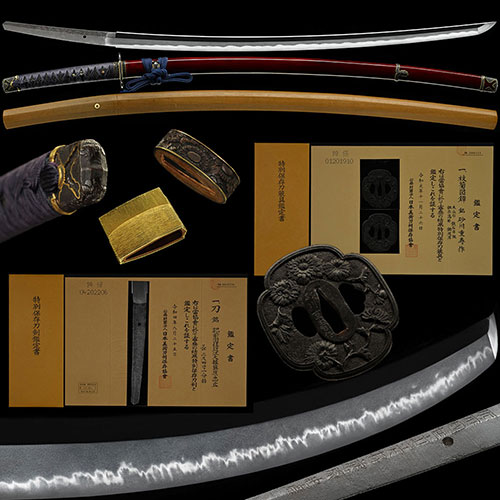
忠広 刀Tadahiro Katana
No.791534刀 近江大掾藤原忠広 一文字写し 究極の小糠肌に変化に富む華やかな丁子乱れ最高傑作 半太刀拵付 二尺四寸一分Katana Oumidaijo Fujiwara Tadahiro Ichimonji copy, Ultimate-Konukahada with rich variety of gorgeous Chouji-Midare, A masterpiece with Handachi-Koshirae 73.0cm
ご成約Sold
- 銘表Mei-Omote
- 近江大掾藤原忠広近江大掾藤原忠広 Oumi Daijo Fujiwara Tadahiro
- 登録証Registration
- 東京都 Tokyo 令和4年2月22日 2/22/4(Reiwa)
- 時代Period
- 江戸前期天和頃Early Edo period, Around Ten period
- 法量Size
-
刃長 73.0cm (二尺四寸一分) 反り 1.6cm
元幅 3.1cm 先幅 2.1cm 元重 0.68cm 鎬厚 0.71cm 先重 0.51cm 鋒長 3.8cm 茎長 21.9cm 重量 836gHachou 73.0cm (二尺四寸一分) Sori 1.6cm
Moto-Haba 3.1cm Saki-Haba 2.1cm Moto-Kasane 0.68cm Shinogi-Thikess 0.71cm Saki-Kasane 0.51cm Kissaki-Chou 3.8cm Nakago-Chou 21.9cm Weight 836g - 国Country
- 肥前Hizen
- 姿Shape
- 鎬造、庵棟、身幅広く、反りやや深く、中鋒やや延びる。Shinogidukuri, Iorimune, Wide Mihaba, Slightly deep Sori, Chu-Kissaki slightly extended.
- 鍛Kitae
- 小杢目肌つみ、地沸微塵に厚くつき、地景細かくよく入り、鉄冴える。Small-Mokumehada-tsumi, Jinie entered fine and thick, Chikei entered finely, Iron is clear.
- 刃文Hamon
- 互の目に、丁子刃交じり、足・葉よく入り、小沸深くつき、砂流し掛り、匂口明るい。Gunome, Mixed Choujiba, There are many Ashi and You, Small-Nie entered deeply, Sunagashi-kakari, Nioikuchi is. bright.
- 帽子Boushi
- 直ぐに小丸。Suguni-Komaru
- 茎Nakago
- 生ぶ、先入山形、鑢目浅い勝手上り、目釘孔一。Ubu, Sakiiriyamagata, Yasurime shallow kattesagari, Mekugiana is one(1).
- ハバキHabaki
- 金着二重。Double Kinkise (Double layered with gold.)
- 拵Sword mounitings
- 茶溜塗鞘半太刀拵
法量
長さ106.2cm 反り4.0cm
説明
鐔 銘 砂川重寿作 鉄石目地枝菊図 日本美術刀剣保存協会 特別保存刀装具 枝菊図鐔
総金具 赤銅枝菊図金覆輪、 目貫 赤銅鳳凰図金色絵。
Cha-Tamenurisaya(Brown lacquered scabbard,)) Handachi Koshirae
Length: 106.2cm
Sori:4.0cm
Tsuba: Mei(signature): Sunakawa Shigetoshi
Tetsu-Ishimeji Eda-Kikuzu Nihon-Bijutsu Token Hozon Kyokai Tokubetsuhozon Tosougu Eda-Kikuzu Tsuba
All Metal fittings: Syakudou Eda Kikuzu(branch and chrysanthemum design) Kinpukurin
Menuki: Syakudou Hououzu(phoenix design) Kiniroe - 説明Drscription
- 近江大掾忠廣は、橋本平作郎といい、初代忠吉の子として慶長十九年に生まれ、寛永九年(1632年)父没後に十九歳にして忠廣を襲名している。寛永十八年(1641年)に近江大掾を受領、元禄六年(1693年)に八十歳で没するまでの六十有余年の長きに渡って作刀を続けている。その為、寛永、寛文、元禄期とそれぞれの時代に応じた体配をした数多くの作品を残しているが、新刀の刀工中、初代忠吉に次ぎ、2番目に多く重要刀剣に指定されており、如何に名刀が多いかが伺える。この刀は、身幅広く、反り深い天和から元禄の姿で、小杢目肌に、地沸が微塵に厚くつき、地景細かくよく入る、究極に美しい小糠肌が冴え、変化に富む華やかな互の目丁子を焼き、足葉よく入り、匂口明るい一文字写しの最高傑作である。Oumino Daijo Tadahiro, called Heisakuro Hashimoto, was born in the 19th year of Keicho as a child of the first Tadayoshi, and was named Tadahiro at the age of 19 after his father died in 1632. He received Oumino Daijo in the 18th year of Kanei (1641), and has continued to make swords for more than 60 years until he died at the age of 80 in the 6th year of Genroku (1693).
For that reason, he has left many works with body arrangements according to each era, such as Kanei, Kanbun, and Genroku, but he is the second most designated Juyo Token after Shinto's Swordsmith, Tadayoshi 1st generation. You can see how many famous swords there are.
This sword has a wide Mihaba, Deep Sori, from the Ten to Genroku period. Small-Mokumehada, Jinie entered fine and thick, Chikei entered finely well, ultimate beautiful Konuka-hada is clear, A gorgeous Gunome-Chouji with a rich variety, There are many Ashi and You. Nioikuchi is bright, It is a masterpiece of Ichimonji copying.



